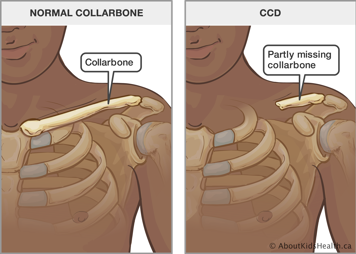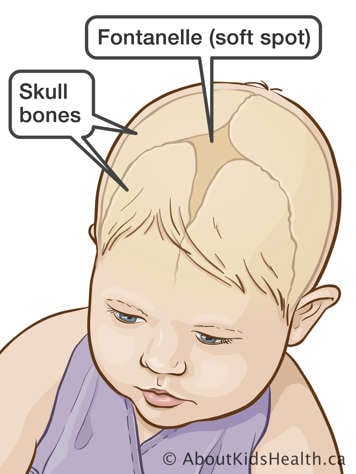What is cleidocranial dysplasia (CCD)?
Cleidocranial dysplasia (say: clie-doh-CRAY-nee-ul diss-PLAY-zee-a) is a genetic condition that mainly affects:
- the development of bones (particularly the skull and collarbones)
- the teeth

How cleidocranial dysplasia affects the body
The symptoms of CCD vary considerably from one person with CCD to another. This is true even of people in the same family who have CCD.
CCD is very rare and occurs in one in one million children worldwide. Both boys and girls can have CCD.

Bone problems
CCD is a disorder of bone development. The various problems of bone development include:
- the spaces between the bones of the skull (fontanelles) take longer than expected to close. In a small percentage of people, the fontanelles may not close completely during their lifetime.
- partly or completely missing collarbones, which can lead to a narrow chest with sloping shoulders
- osteoporosis (lower bone density)
- narrow pelvis and/or abnormal shape of the pelvic bones
- shorter stature (height)

Dental problems
People with CCD lose their primary teeth (baby teeth) and get their secondary teeth (adult teeth) late. This causes overcrowding of teeth and mal-alignment of the jaw.
Height and body shape
People with CCD can be shorter in height. The final height of boys is about six inches shorter than expected. For girls, the final height is about three inches shorter.
People with CCD are more likely to have other changes in their bones like:
- short, tapered fingers and broad thumbs
- flat feet
- knocking knees
Osteoporosis
People with CCD have a higher chance to develop osteoporosis (low bone density). The bone density is measured by a special test called a DEXA scan.
Medical problems
People with CCD often have recurrent chest, sinus and ear infections. Repeated ear infections may cause hearing loss.
Caesarean section
Women with CCD are more likely to need a Caesarean section to give birth because they have a narrow pelvis and/or abnormally shaped pelvic bones.
Intellectual development
People with CCD have normal intelligence.
Cleidocranial dysplasia is a genetic condition
Genetic means related to genes. Each of us inherits our genes from our parents. Genes provide our bodies with instructions that influence our health, looks and behavior. In general, each person has two copies of every gene. One copy is inherited from the mother and the other from the father.
The RUNX2 gene helps regulate the development of bone and cartilage. CCD occurs as a result of a mutation (change) in one copy of the RUNX2 gene.
- In most people with CCD, this is a new mutation, meaning neither parent has CCD.
- However, in a small percentage of people with CCD, the mutation is inherited (passed on) from one of the parents.
CCD is an autosomal dominant condition. This means that:
- Only one copy of the RUNX2 gene has a mutation in a person with CCD. The other copy of the gene works normally, but this is not enough to prevent a person from having CCD.
- A person with CCD has a 50% chance during each pregnancy of passing this genetic condition on to the child.
- The risk to the sibling (brother or sister) of a person with CCD depends on if the parent has CCD or not.

Cleidocranial dysplasia can be diagnosed before or after birth
Before birth, CCD can be diagnosed by testing DNA taken from the fetus. This can be obtained in one of the following ways:
- by amniocentesis after the 15th week of pregnancy
- by chorionic villus sampling (CVS) between the 11th and 14th week of pregnancy
These methods are used for high-risk pregnancies, for instance if the parents have another child diagnosed with CCD or one of the parents has CCD.
To be eligible for this testing, the mutations in the gene responsible for causing CCD in the family must be known. This means genetic testing (a blood test) must be done on the person in the family with CCD.
CCD may be diagnosed before birth using ultrasound to look for features of CCD. However, a normal ultrasound does not guarantee that the baby will not have CCD.
After birth, the diagnosis of CCD is based on X-ray findings and physical examination. A diagnosis of CCD can be confirmed by DNA testing of the RUNX2 genes (a blood test).
Treatment of cleidocranial dysplasia
Children with CCD can lead fulfilling lives if they receive attentive, informed care from their parents and health-care providers. The treatment is based on the early detection and management of the various symptoms and complications. People with CCD have a normal life expectancy.
Treatment of dental problems
Early referral to a dental clinic familiar with CCD allows for timely planning of necessary procedures. The goal of treatment is to:
- improve the appearance of the teeth
- enhance the ability to chew
This may be achieved by a combination of dental procedures which may include surgery.
Speech therapy
Speech therapy is sometimes needed during the dental treatment process.
Treatment of recurrent infections
Sinus and ear infections need timely treatment with proper medication.
Prevention of head injuries
If your child has large openings between the skull bones (fontanelles), the head should be protected from blunt trauma. Your child should use helmets during high-risk activities such as bicycling, skateboarding and baseball.
Calcium and Vitamin D supplementation
If your child has low bone density (osteoporosis), your child's doctor may suggest calcium and vitamin D supplements to strengthen the bones. Talk to your doctor.
Monitoring of pregnant women
Pregnant women with CCD should be monitored carefully. They may need a Caesarean section for delivery.
Coping with cleidocranial dysplasia
Most people with CCD lead healthy and active lives. In general, children with visible differences like short stature can have difficulties in school and society. Encourage your child to participate in activities with other children the same age. As well, try to physically adapt your child's surroundings to support your child and encourage independence. Speak to your health care team if you need help or advice or if you are having trouble coping.
Genetic counselling for cleidocranial dysplasia
People with CCD and their families should consider assessment by a geneticist and genetic counsellor. They can help with the following:
- confirming the diagnosis
- discussing the natural history of the disease
- evaluating the risk that future children will also be affected
- discussing available options for managing the disease
Patient resources
The following organizations and sites can offer more information, support and contact with other affected people and their families.
- Children's Craniofacial Association: www.ccakids.org
- The National Cranio-facial Association: www.faces-cranio.org
- The Human Growth Foundation: www.hgfound.org
- MUMS (Mothers United for Moral Support) National Parent-to-Parent Network: www.netnet.net/mums/